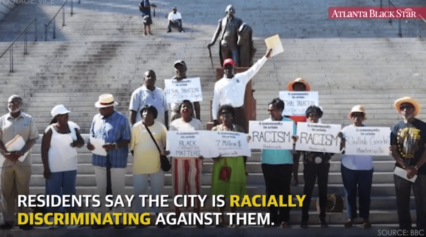
Plantation slave houses South Carolina Low Country (Source: Wikimedia Commons)
At its height, Black land ownership was impressive. At the turn of the 20th century, formerly enslaved Black people and their heirs owned 15 million acres of land, primarily in the South, mostly used for farming. In 1920, the 925,000 African-American farms represented 14 percent of the farms in America. Sadly, things turned for the worse, as 600,000 Black farmers were forced off their land, with only 45,000 Black farms remaining in 1975. Now, Black folks are only 1 percent of rural landowners in the U.S., and under 2 percent of farmers. Of the 1 billion acres of arable land in America, Black people today own a little more than 1 million acres, according to AP.
During the Obama administration, the U.S. Department of Agriculture settled with Black farmers for $2.3 billion for their longstanding claims of discrimination in farm loans and other government programs.
Over the years, Black people have lost their land through a number of circumstances, including government action, deception and a reign of domestic terror in the South that forced Black people from their homes through threats of violence and lynching. That terror and economic exploitation precipitated the Great Migration, which resulted in the uprooting of over 6 million Black people from the South and their relocation to the North, Midwest and West between 1916 and 1970.
How we lost the land is an untold story. An investigation by AP documented the process by which people were tricked or intimated out of their property. In this study of 107 land takings in 13 Southern and border states, 406 landowners lost over 24,000 acres of farm and timber land and 85 properties such as city lots and stores. The property, which today is owned by white people and corporations, is valued in the tens of millions of dollars. In recent years, groups such as the Federation of Southern Cooperatives in Atlanta and the Land Loss Prevention Project in Durham, N.C., receive new reports of land takings on a regular basis, while the Penn Center in St. Helena Island, S.C., has gathered 2,000 such cases. One story from the AP provides the context by which families lost their land to thievery and violence:
After midnight on Oct. 4, 1908, 50 hooded white men surrounded the home of a black farmer in Hickman, Ky., and ordered him to come out for a whipping. When David Walker refused and shot at them instead, the mob poured coal oil on his house and set it afire, according to contemporary newspaper accounts. Pleading for mercy, Walker ran out the front door, followed by four screaming children and his wife, carrying a baby in her arms. The mob shot them all, wounding three children and killing the others. Walker’s oldest son never escaped the burning house. No one was ever charged with the killings, and the surviving children were deprived of the farm their father died defending. Land records show that Walker’s 2 1/2-acre farm was simply folded into the property of a white neighbor. The neighbor soon sold it to another man, whose daughter owns the undeveloped land today.
Land is among the most important assets people can own. Certainly, for the rural society in which many African Americans traditionally have lived, land represented prosperity, intergenerational wealth, family and community. According to the U.S. Agency for International Development (USAID), land can be “a vital part of cultural and social identities, a valuable asset to stimulate economic growth and a central component to preserving natural resources and building societies that are inclusive, resilient and sustainable.”
“It’s more about land as a home, it’s about economics and culture, all rolled up into one,” Jennie L. Stephens, executive director of the Center for Heirs’ Property Preservation said. Based in Charleston, S.C., the organization serves 15 counties in the Palmetto State, including the Lowcountry, where Gullah-Geechee have struggled to hold onto their ancestral homelands on the Sea Islands in the face of development, gentrification and corporate intrusion. For generations, families have had the land, procured through the blood, sweat and tears of their ancestors, until many are forced to sell it.
The Center promotes sustainable land use to help historically underserved families realize the wealth-building asset of their land, and prevents heirs’ property owners from losing their land. Under the concept of heirs’ property, a form of communal land ownership found among rural communities of the South, both Black and white, numerous heirs of the original landowner are co-owners of the land, each owning a percentage share. They may be 20, 30, 40 or more people scattered around the country, and in some cases, have never visited the land and may not even know they are co-owners. The problem arises when corporations and developers entice family members to sell their share, becoming family members themselves and forcing a partition sale, a court-mandated auction sale of the land, all without notice to the other family members.
“It is a real issue,” said Tish Lynn, director of communications at the Center for Heirs’ Property Preservation. Lynn said that across the Southeast and throughout the country, land has been in the hands of African-American families through heirs’ titles, passed from generation to generation without a clear title to the land. Rather, land was passed through oral tradition, without access to the judicial system or the ability to hire a lawyer. Although heirs’ property is a rural characteristic rather than a racial one, for Black people who have had more than their share of exploitation, the suffering is compounded. “I talk about it as an injustice. We call it legalized theft. We’re trying to level the playing field by clearing the title,” Lynn said.
Jennie Stephens noted that while the issue of land loss is not new, it is receiving more attention these days. Indigenous Black landowners now find themselves grappling with the same land loss issues facing Native Americans. Once thought to be the most unproductive land, now everyone wants to live in the Sea Islands area. Lynn calls the Charleston coastal area a magnet, with “40 new people coming every day, and the attraction of industry, Boeing, Volvo and the desirability of living here has logarithmically increased the pressure of development.” Hurricane Hugo helped shine a light on issues facing the coast as forests amid these heirs’ properties were destroyed. With few laws on the books to protect landowners, it is easily lost and families torn apart.
“We started to look at the tax-assessed value of the land of all the individuals we provide legal advice and counsel,” Stephens said of the clients whose land her organization seeks to protect, which is roughly 300 people each year. “Over the last year, the tax-assessed value is $38.4 million,” she noted.
Hilton Head Island is a most salient example of once-predominantly Black-owned land that is now in majority white hands, due in no small measure to partition sales. Beaufort County, S.C., which includes Hilton Head, was 57 percent Black in 1950 but is now 77 percent white, as The Nation reported, with Black farmers falling from half of all farmers throughout the state to only 7 percent today.
For heirs’ property owners, clearing the title to the land is a key to helping them use it as an economic engine. “When natural disasters occur, they cannot access FEMA funds because they don’t have clear title. You can’t apply for any other housing rehab programs that require clear title. Where does that leave you? You need a bucket or you have to move,” Stephens said. “Oftentimes, landowners don’t come and ask for help until there is an emergency or there has been an increase in the [tax] assessment of the property. … If people don’t receive help in title issues, the land will be lost. The land will become a gated community. Boeing is expanding, Volvo is expanding. Some of our folk are already being asked, ‘Do you want to sell your land?’”
The land loss these Black populations are experiencing is a gentrification issue transposed onto rural communities, as Lynn noted. While it is an economic issue, it is also an environmental one, as Stephens emphasized: “Once the land is lost, it is not left green anymore. Now, you see these condos with asphalt. It does not only impact the landowner but entire communities,” she noted, adding that people who moved there because they loved the way the land looks are themselves changing the way the land originally looked.
There is some relief in sight for heirs’ property owners in South Carolina, in what could signal a trend for the rest of the South. In 2016, then-Gov. Nikki Haley signed the Clementa C. Pinckney Uniform Partition of Heirs’ Property Act, named in honor of the state lawmaker among the eight murdered in an act of racial terror at Charleston’s Emanuel AME Church in 2015. The law allows co-tenants to buy out the shares of land speculators — making it difficult for land to be sold through the courts — and allows judges to consider factors such as the sentimental, ancestral and fair market value of the property.
While the Pinckney Act is one example in the right direction, throughout the nation, Black wealth is continuously undercut. For example, the Great Recession, and the attendant subprime mortgage crisis that preyed upon Black and Latino homeowners through institutional racism and discriminatory lending, was a period of historic losses of wealth. According to the Urban Institute, Black families lost 31 percent of their wealth between 2007 and 2010, Hispanics 44 percent. As a result, the racial wealth gap continues and Black folks find themselves hamstrung, unable to build for the future and pass down their legacy to successive generations.
“If you can get people to maximize their potential through land, they don’t need a handout,” Jennie Stephens said, underscoring the importance of owning the land and building family wealth. “It is time for your child to go off to college. Maybe you have had trees growing for awhile. One person who has clear title, they had the trees cut off their land and were able to send their children to college without student loans. That money was not a loss to their family, literally that wealth was passed to their family,” she added. “That’s a very simple example of wealth building, the fact these children can come out of college without a student loan. You’re starting out and not in the negative. And if your parents managed that land, you get to go back and cut the trees again. If you have clear title, you can get a mortgage and a home equity line of credit.”


